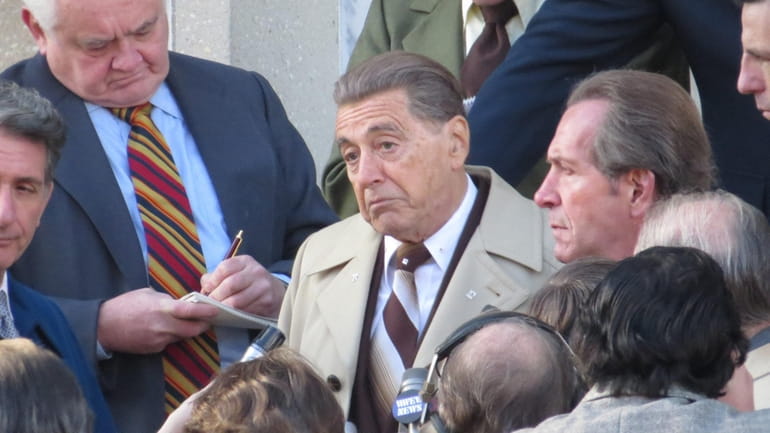Hochul touts expanding movie/TV subsidies, but critics are dubious

Al Pacino during filiming of "The Irishman" on Long Island in November 2017. The steps of Hempstead Town Hall were turned into a movie set. Credit: Jim Staubitser
ALBANY — Gov. Kathy Hochul proposes to expand the state’s subsidy to the film, TV, music and theater industries because they create jobs and provide the state with worldwide exposure. But her plan faces criticism backed by independent studies and the experience of some other states that concluded the investment provides a questionable return for taxpayers.
The State Legislature is now considering Hochul’s proposal for the state budget, which is due April 1.
Hochul would expand the film credit to make New York “a national magnet for productions” while subsidizing thousands of jobs and providing customers for small businesses such as caterers and hotels, according to the state Division of Budget. Hochul would extend the subsidy program through 2034 and increase the annual tax credits to $700 million a year, from $420 million.
The program would allow a tax credit for 30% of the cost of productions in New York state. That would be up from the current 25% maximum, which was a reduction made in 2020 when all tax revenues were threatened by the COVID-19 virus. In addition, Hochul’s proposal for the first time would include tax credits for “above-the-line” salaries, including performers, directors and writers.
Hochul also would expand the tax credit for musical and theatrical performances from $200 million to $300 million. Hochul has noted that Broadway is a key driver of tourism to New York City.
1,502 projects subsidized since 2014
The Empire State Development agency said that since 2014, the program subsidized 1,502 projects that created more than 1.7 million hires and more than $35 billion in private-sector spending. For every dollar in tax credit provided, the state collects $1.40 in tax revenue, the office said.
On Long Island, more than 2,000 days of filming has been shot since 2017, including the films “John Wick” and Adam Sandler’s “Uncut Gems,” and the HBO series “The Gilded Age.” There are eight production facilities on Long Island and more than 3,900 of these and other entertainment workers live on Long Island, according to the ESD.
“This is not movie magic, it's basic economics,” ESD spokeswoman Kristin Devoe said. “New York’s film industry brings jobs and investment to our state, provides a return on investment for New York taxpayers, and is vital to our economy.”
But others see tax credits for the multibillion entertainment industry to create what are mostly temporary jobs as a waste of resources. These detractors say the tax credits haven't been proved to be effective job-creators or even necessary to bring productions to New York, which long has been one of the world's entertainment meccas.
The criticism increased this year because of Hochul's proposal to include the salaries of performers, directors and writers in the costs that could be subsidized.
“Do we really need to subsidize people at that level?” asked Senate Finance Committee chairwoman Liz Krueger (D-Manhattan) in a February budget hearing. “Why are we doing that? We always said, ‘No,’ before.”
She’s not alone in questioning the proposal. Academic studies dating to 2016 questioned the value of the whole idea of tax subsidies for the multibillion dollar entertainment industry. Financial analysis by agencies for the states of California, Pennsylvania and Virginia have found that quantifying the benefit is difficult and the payoff often appears to be small compared with job subsidies in other industries, according to the National Conference of State Legislatures.
Number of states offering credits falls
Similar research prompted states such as Louisiana to end its film and TV tax credits, while others reduced the benefits, according to the NCSL. In 2010, 45 states, Washington, D.C., and Puerto Rico offered the tax credits. Today that total has dropped to 35 states, along with D.C., Puerto Rico and the U.S. Virgin Islands. But those 35 states include 15 that have begun or expanded tax subsidies since 2021, when the film and TV industry was trying to rebound from the COVID-19 pandemic, according to the NCSL.
In 2015, for example, Michigan ended its film tax breaks. But lawmakers now propose reviving it to reenter the race against states for these jobs and exposure. Supporters of the subsidies often point to Georgia’s experience creating a multibillion-dollar film industry, which has included TV’s “The Walking Dead” and its spinoff series; several Tyler Perry productions, “ATL,” the “Black Panther” film, and the streaming hit “Ozark.”
Not everyone believes that script should be followed.
“Tax incentives for film and television production are an inefficient use of public resources,” said Michael Thom, an associate professor at Southern California University’s Price School of Public Policy who specializes in public finance. Although there may be short-term gains of temporary jobs, job growth was “nonexistent,” the study found.
“States that continue to offer them, like New York, tend to pay more attention to the industry, its lobbyists, and unions than the evidence, which is quite clear and always has been,” Thom told Newsday.
Last week, the independent Citizens Budget Commission said the state has failed to conduct a “rigorous evaluation” of the program, a view the state denies.
“No evidence has been presented that the proposed expansion, which would increase the total lifetime cost by 55%, from $9.4 billion to $14.6 billion, would be economically beneficial,” said Patrick Orecki of the CBC.
“Participating in a back-and-forth leapfrogging of ever more generous incentives only accelerates a race to the bottom, diminishing revenues instead of competing on New York’s comparative advantages,” Orecki told Newsday. “The question for legislators is whether this program is the best use of $700 million per year.”
Cuomo got donations from Hollywood figures
For politicians, the program produces Instagram shots from stars including Queen Latifah and Julianne Moore and attracts campaign contributions not just from TV and film interests, but the politically powerful unions in New York State whose members are hired for the productions.
Former Gov. Andrew M. Cuomo made campaign trips to Los Angeles and other California events over his three terms that resulted in more than $3.7 million in contributions to his campaigns, according to state Board of Elections records. Those political donations came from Hollywood titans including director Steven Spielberg, producer Jeffrey Katzenberg, NBC Universal Media and the NY Film Political Action Committee based in Los Angeles. Hochul has tapped many of the same sources, for a total of $519,370 so far from California donors, state records show.
But critics say the value to New Yorkers at large remains hard to quantify.
“Many if not most [productions] would be shot in New York regardless, because that’s where so much studio and talent infrastructure is located,” said Ken Girardin of the fiscally conservative Empire Center think tank. "The idea that New York's film credit pays for itself is Hollywood-level fantasy. These are refundable tax credits, meaning the state typically gives producers cash.
“Even if there weren't a cost and taxpayers somehow broke even, this is $420 million that isn't being used to cut taxes, or pave roads or address other public concerns,” Girardin told Newsday, citing the current total subsidy. “How much would $420 million in personal income tax or corporate franchise tax relief do for the state’s job picture?”

